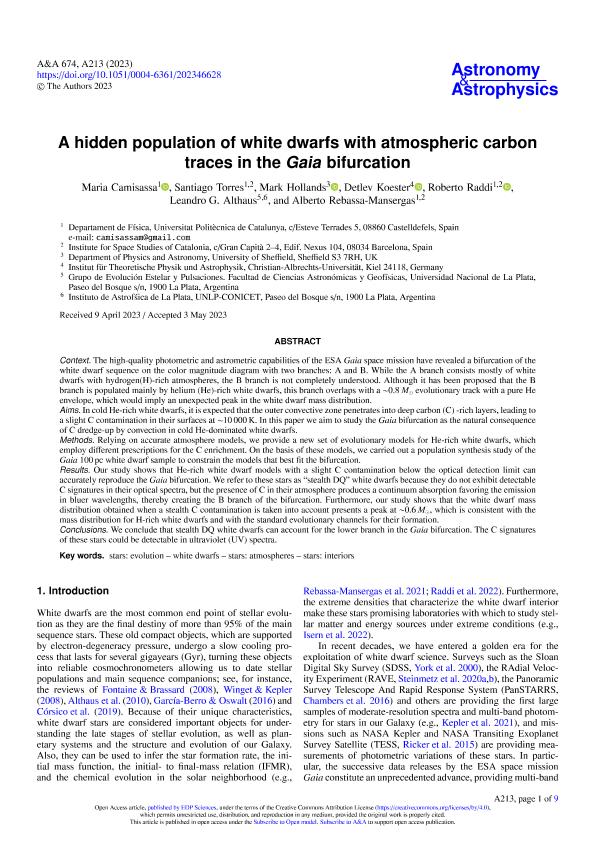Artículo
A hidden population of white dwarfs with atmospheric carbon traces in the Gaia bifurcation
Camisassa, Maria; Torres, Santiago; Hollands, Mark; Koester, Detlev; Raddi, Roberto; Althaus, Leandro Gabriel ; Rebassa Mansergas, Alberto
; Rebassa Mansergas, Alberto
 ; Rebassa Mansergas, Alberto
; Rebassa Mansergas, Alberto
Fecha de publicación:
06/2023
Editorial:
EDP Sciences
Revista:
Astronomy and Astrophysics
ISSN:
0004-6361
Idioma:
Inglés
Tipo de recurso:
Artículo publicado
Clasificación temática:
Resumen
Context. The high-quality photometric and astrometric capabilities of the ESA Gaia space mission have revealed a bifurcation of the white dwarf sequence on the color magnitude diagram with two branches: A and B. While the A branch consists mostly of white dwarfs with hydrogen(H)-rich atmospheres, the B branch is not completely understood. Although it has been proposed that the B branch is populated mainly by helium (He)-rich white dwarfs, this branch overlaps with a â ¼0.8â Mâ evolutionary track with a pure He envelope, which would imply an unexpected peak in the white dwarf mass distribution. Aims. In cold He-rich white dwarfs, it is expected that the outer convective zone penetrates into deep carbon (C) -rich layers, leading to a slight C contamination in their surfaces at â ¼10â 000 K. In this paper we aim to study the Gaia bifurcation as the natural consequence of C dredge-up by convection in cold He-dominated white dwarfs. Methods. Relying on accurate atmosphere models, we provide a new set of evolutionary models for He-rich white dwarfs, which employ different prescriptions for the C enrichment. On the basis of these models, we carried out a population synthesis study of the Gaia 100 pc white dwarf sample to constrain the models that best fit the bifurcation. Results. Our study shows that He-rich white dwarf models with a slight C contamination below the optical detection limit can accurately reproduce the Gaia bifurcation. We refer to these stars as â stealth DQâ white dwarfs because they do not exhibit detectable C signatures in their optical spectra, but the presence of C in their atmosphere produces a continuum absorption favoring the emission in bluer wavelengths, thereby creating the B branch of the bifurcation. Furthermore, our study shows that the white dwarf mass distribution obtained when a stealth C contamination is taken into account presents a peak at â ¼0.6â Mâ , which is consistent with the mass distribution for H-rich white dwarfs and with the standard evolutionary channels for their formation. Conclusions. We conclude that stealth DQ white dwarfs can account for the lower branch in the Gaia bifurcation. The C signatures of these stars could be detectable in ultraviolet (UV) spectra.
Palabras clave:
STARS: ATMOSPHERES
,
STARS: EVOLUTION
,
STARS: INTERIORS
,
WHITE DWARFS
Archivos asociados
Licencia
Identificadores
Colecciones
Articulos(IALP)
Articulos de INST.DE ASTROFISICA LA PLATA
Articulos de INST.DE ASTROFISICA LA PLATA
Citación
Camisassa, Maria; Torres, Santiago; Hollands, Mark; Koester, Detlev; Raddi, Roberto; et al.; A hidden population of white dwarfs with atmospheric carbon traces in the Gaia bifurcation; EDP Sciences; Astronomy and Astrophysics; 674; A213; 6-2023; 1-9
Compartir
Altmétricas



